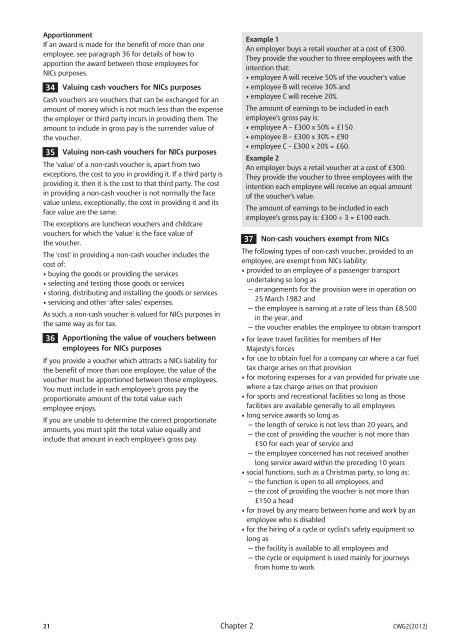Employer Further Guide to PAYE and NICs - HM Revenue & Customs
Employer Further Guide to PAYE and NICs - HM Revenue & Customs
Employer Further Guide to PAYE and NICs - HM Revenue & Customs
Create successful ePaper yourself
Turn your PDF publications into a flip-book with our unique Google optimized e-Paper software.
Apportionment<br />
If an award is made for the benefit of more than one<br />
employee, see paragraph 36 for details of how <strong>to</strong><br />
apportion the award between those employees for<br />
<strong>NICs</strong> purposes.<br />
34 Valuing cash vouchers for <strong>NICs</strong> purposes<br />
Cash vouchers are vouchers that can be exchanged for an<br />
amount of money which is not much less than the expense<br />
the employer or third party incurs in providing them. The<br />
amount <strong>to</strong> include in gross pay is the surrender value of<br />
the voucher.<br />
35 Valuing non-cash vouchers for <strong>NICs</strong> purposes<br />
The ‘value’ of a non-cash voucher is, apart from two<br />
exceptions, the cost <strong>to</strong> you in providing it. If a third party is<br />
providing it, then it is the cost <strong>to</strong> that third party. The cost<br />
in providing a non-cash voucher is not normally the face<br />
value unless, exceptionally, the cost in providing it <strong>and</strong> its<br />
face value are the same.<br />
The exceptions are luncheon vouchers <strong>and</strong> childcare<br />
vouchers for which the ‘value’ is the face value of<br />
the voucher.<br />
The ‘cost’ in providing a non-cash voucher includes the<br />
cost of:<br />
• buying the goods or providing the services<br />
• selecting <strong>and</strong> testing those goods or services<br />
• s<strong>to</strong>ring, distributing <strong>and</strong> installing the goods or services<br />
• servicing <strong>and</strong> other ‘after sales’ expenses.<br />
As such, a non-cash voucher is valued for <strong>NICs</strong> purposes in<br />
the same way as for tax.<br />
36 Apportioning the value of vouchers between<br />
employees for <strong>NICs</strong> purposes<br />
If you provide a voucher which attracts a <strong>NICs</strong> liability for<br />
the benefit of more than one employee, the value of the<br />
voucher must be apportioned between those employees.<br />
You must include in each employee’s gross pay the<br />
proportionate amount of the <strong>to</strong>tal value each<br />
employee enjoys.<br />
If you are unable <strong>to</strong> determine the correct proportionate<br />
amounts, you must split the <strong>to</strong>tal value equally <strong>and</strong><br />
include that amount in each employee’s gross pay.<br />
Example 1<br />
An employer buys a retail voucher at a cost of £300.<br />
They provide the voucher <strong>to</strong> three employees with the<br />
intention that:<br />
• employee A will receive 50% of the voucher’s value<br />
• employee B will receive 30% <strong>and</strong><br />
• employee C will receive 20%.<br />
The amount of earnings <strong>to</strong> be included in each<br />
employee’s gross pay is:<br />
• employee A – £300 x 50% = £150<br />
• employee B – £300 x 30% = £90<br />
• employee C – £300 x 20% = £60.<br />
Example 2<br />
An employer buys a retail voucher at a cost of £300.<br />
They provide the voucher <strong>to</strong> three employees with the<br />
intention each employee will receive an equal amount<br />
of the voucher’s value.<br />
The amount of earnings <strong>to</strong> be included in each<br />
employee’s gross pay is: £300 ÷ 3 = £100 each.<br />
37 Non-cash vouchers exempt from <strong>NICs</strong><br />
The following types of non-cash voucher, provided <strong>to</strong> an<br />
employee, are exempt from <strong>NICs</strong> liability:<br />
• provided <strong>to</strong> an employee of a passenger transport<br />
undertaking so long as<br />
— arrangements for the provision were in operation on<br />
25 March 1982 <strong>and</strong><br />
— the employee is earning at a rate of less than £8,500<br />
in the year, <strong>and</strong><br />
— the voucher enables the employee <strong>to</strong> obtain transport<br />
• for leave travel facilities for members of Her<br />
Majesty’s forces<br />
• for use <strong>to</strong> obtain fuel for a company car where a car fuel<br />
tax charge arises on that provision<br />
• for mo<strong>to</strong>ring expenses for a van provided for private use<br />
where a tax charge arises on that provision<br />
• for sports <strong>and</strong> recreational facilities so long as those<br />
facilities are available generally <strong>to</strong> all employees<br />
• long service awards so long as<br />
— the length of service is not less than 20 years, <strong>and</strong><br />
— the cost of providing the voucher is not more than<br />
£50 for each year of service <strong>and</strong><br />
— the employee concerned has not received another<br />
long service award within the preceding 10 years<br />
• social functions, such as a Christmas party, so long as:<br />
— the function is open <strong>to</strong> all employees, <strong>and</strong><br />
— the cost of providing the voucher is not more than<br />
£150 a head<br />
• for travel by any means between home <strong>and</strong> work by an<br />
employee who is disabled<br />
• for the hiring of a cycle or cyclist’s safety equipment so<br />
long as<br />
— the facility is available <strong>to</strong> all employees <strong>and</strong><br />
— the cycle or equipment is used mainly for journeys<br />
from home <strong>to</strong> work<br />
21 Chapter 2 CWG2(2012)

















